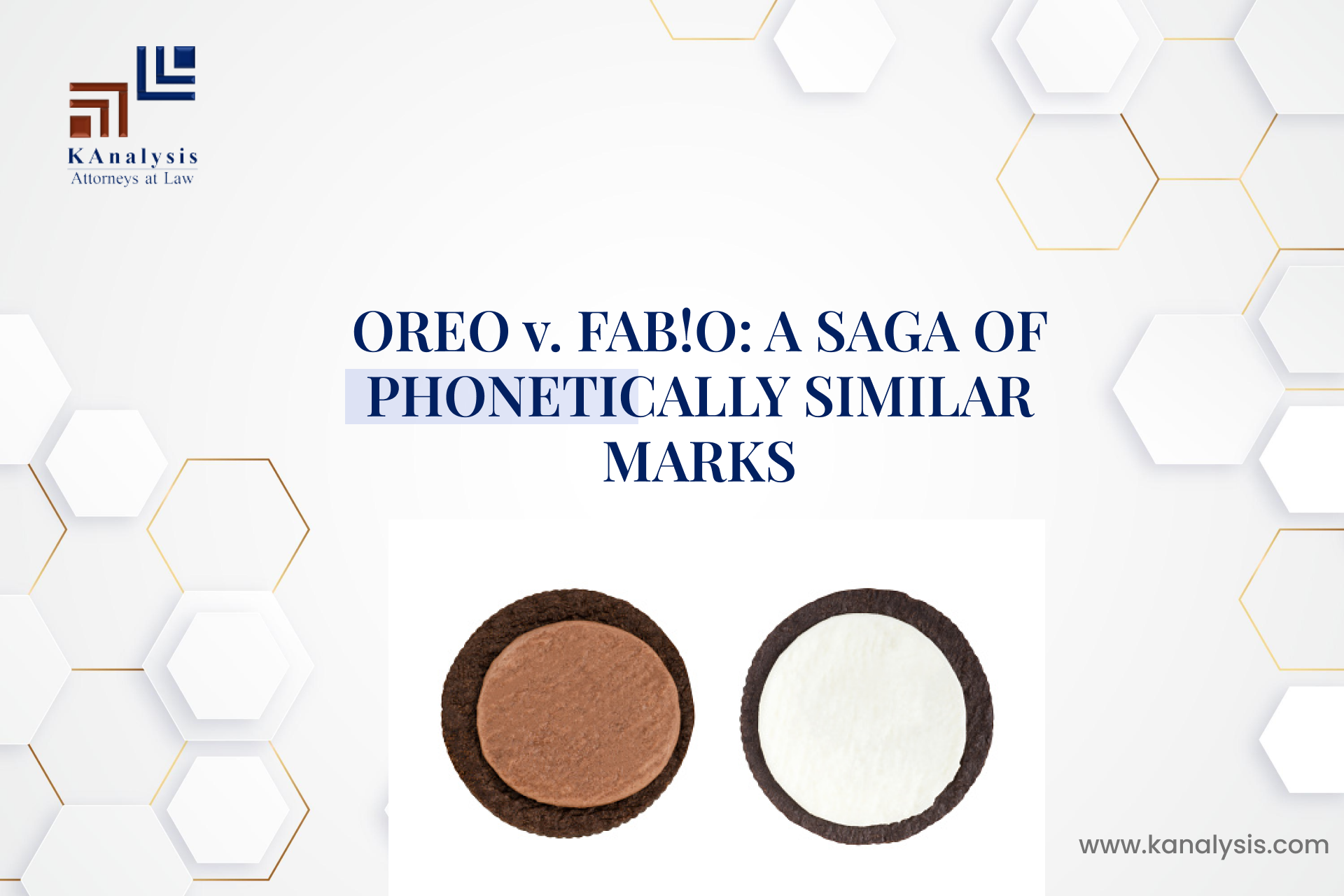Trademark infringement refers to the unauthorised use of a mark, which is identical or deceptively similar to a trademark that is already registered. The term “deceptive similarity” as defined under Section 2 (h) of the Trade Marks Act, 1999 (hereinafter referred to as “the Act”) means any kind of similarity, which deceives the general public and relates in one way or other to the well-known trademark. It has to be sufficiently similar so that the consumer might be confused and might mix up the two products thinking of them to be the same. The test in such a case is not that of absolute confusion but even the likelihood of confusion is sufficient. Hence, the product’s get-up layout, and also, the colour combination of the packaging plays a significant role at the point of purchase.[1]
PHONETICALLY SIMILAR MARKS
The provisions dealing with the infringement of a registered mark as a result of phonetic similarity are provided under S. 29(9) of the Act. It states that a mark may be infringed by the spoken use as well as the visual representation of words. The Supreme Court has on several occasions affirmed that a comparison of trademarks must be done concerning both ears as well as the eyes.
Phonetic similarity as one of the fundamental tests of comparison was laid down in the landmark case of Cadila Healthcare Ltd. v. Cadila Pharmaceuticals Ltd.[2] where the Supreme Court observed that it was not correct in law to hold that the principle of phonetic similarity cannot be used when the manner in which the conflicting words are written is different.
An important application of this principle in this regard can be seen in Consitex SA v. Kamini Jain and Ors.[3] where the Delhi High Court was tasked with the decision on two similar sounding marks ‘Zegna’, an Italian luxury fashion brand, (pronounced Zen-Yah) and ‘Jenya’. The court here leaned in favour of the plaintiff to hold that Jenya was a deceptively similar trademark. The importance of the pronunciation here is such that had Zegna not adduced documents in support of the pronunciation of Zegna as ‘Zen-Yah’, the Court may not have decided in their favour as the two marks otherwise differ significantly.
Quite recently in the case of Intercontinental Great Brands v. Parle Product Private Limited[4], also known as Oreo v. Fab!o case, the Hon’ble Delhi High Court decided in favour of the plaintiff. The defendants were restrained from using the marks FABIO or FAB!O and were also restrained from manufacturing, or selling their vanilla cream-filled chocolate biscuits using the deceptively similar trade dress. It is discussed in detail below-
BRIEF FACTS OF THE CASE
The plaintiff ‘Intercontinental Great Brands’ is a US-based, Mondelez International manufacturing the famous ‘OREO’ biscuits and the defendants are FMCG company ‘Parle’ manufacturing the biscuits named ‘FAB!O’ in dispute. The plaintiffs have alleged that the defendants introduced their cream-filled chocolate sandwich biscuits under the mark FAB!O in the market in 2020 which were identical to those of the plaintiff OREO trademark. Plaintiff stated that before 2020 the defendants were using FAB and FAB! for their biscuits.
Further, the plaintiff alleged that the mark on the defendant’s biscuit, though written FAB!O is bound to be pronounced FABIO. The mark is, therefore, according to the plaintiff, deceptively similar to the plaintiff’s OREO mark. As well as trade dress of the defendant’s biscuit is deceptively similar to that of the plaintiff.
OBSERVATION OF THE COURT
The court while deciding the case addressed the following legal issues:
Deceptive Similarity
- The Court agreed with the view taken by the plaintiffs that the deceptive similarity is to be viewed from the point of view of initial interest confusion. In the case of Shree Nath Heritage Liquor Pvt. Ltd. v. Allied Blender & Distilleries Pvt. Ltd.[5], where in initial interest confusion is defined along with other types of confusion, as “the confusion that may be caused initially, i.e., prior to purchase, but at the time of purchase of the alleged infringer/tort feaser’s product or using its service, the consumer is not confused.” Thus, when the defendants enter the market with the identical vanilla cream-filled chocolate sandwich cookie, named FAB!O concluding with the ‘IO’ sound, there is a possibility that a consumer who had the plaintiff’s biscuit earlier might end up associating FAB!O with OREO biscuits. This satisfies the test of initial interest confusion.
Phonetic Similarity
- The Court while rejecting the contention of the defendants as to predicated dissimilarity between the first syllable of FAB!O and OREO, relied on, Amritdhara Pharmacy v. Satya Deo Gupta[6]and Pankaj Goel v. Dabur India Ltd.[7]and held that the marks HAJMOLA and RASMOLA to be similar. ‘Haj’ and ‘Ras’ are no less dissimilar from each other than ‘Fab’ and ‘Or’.
- The existence of phonetic similarity was affirmed by the Court, as the sound ‘EO’ in the OREO is a unique feature associated with the plaintiff’s product. It distinguished the biscuits in the mind of the average consumer of imperfect recollection. Further, in the biscuit industry, there is no other biscuit with a similar sounding name, concluding with the ‘EO’ sound. The addition of ‘O’ in the pre-existing FAB! mark to be pronounced as ‘fab-ee-yo’ of the defendant renders the concluding letters of the defendant’s mark ‘IO’ phonetically identical to the concluding letters ‘EO’ of the plaintiff’s mark OREO which leads to creating confusion in the mind of the consumer.
- The Court further opined that the addition of ‘O’ solely for the packs in which cream-filled chocolate sandwich biscuits were packed and sold is indicative of the fact that the defendant wanted to capitalize on the goodwill earned by the plaintiff and the same was prima facie deliberate act.
Trade Dress
- The defendants used the blue colour pack only for their vanilla cream-filled chocolate sandwich biscuits and the pictures of the black cookies with white vanilla filling on the pack, further asserted the fact that a person of average intelligence is likely to associate the biscuits of the plaintiff and defendants together.
- The Court answered in the affirmative that there is deceptively similarity to the trade dress of the plaintiff’s vanilla cream-filled OREO chocolate cookie.
Design
- In this issue the Court agreed with the defendants that though plaintiffs have a trademark over its design, apart from a ridge, running along the circumference of the biscuit and a few dashes the design is very different. Further, the court stated that the biscuits are being sold in a pack and not in individual pieces, it is unlikely that people would be confused by the design.
ANALYSIS OF THE CASE
The confusion created by the availability of multiple “deceptively similar” products in the market is a problem that troubles the consumer. Due to this, the consumer often ends up buying something that he did not intend to buy. This leads to a loss of the consumers and producer as he might lose on his potential sales and consumer base. The judgement paves way for effective protection of the intellectual property rights of the owners and even the slightest possibility of similarity amongst the products, which is likely to create confusion amongst the consumers, would be regarded as infringing goods and the owners of the same would be injuncted from their dissemination in the market.
In previous cases, ITC filed suit against Britannia in 2016 alleging trademark infringement. ITC contended that the packaging of Britannia’s NutriChoice Digestive Zero biscuits was identical to that of ITC’s Sunfeast Farmlite Digestive All Good biscuit. The Court decided in favour of ITC and asked Britannia to curb the sale of its NutriChoice Zero biscuits.[8] In Oreo v. Twins[9], the plaintiff ‘Twins’ from Spain presented their case in front of the European Court of Justice (CJEU) for registration of their mark. Oreo filed their opposition to this and claimed their popularity and earlier trade mark which was similar to the Twins. The request of the plaintiff was refused by EUIPO citing the likelihood of confusion as a reason with the earlier and better-established Oreo brand.
CONCLUSION
With the advent of globalization and products penetrating every nook and corner of the world, the protection of intellectual property has become one of the major concerns for producers. Laws must be adequately implemented, to put a restraint on such efforts disrupting ethical trade. The biscuit industry unfortunately has fallen victim to several such cases where leading brands had to sue each other for trade mark infringement. The legal battles can take a significant toll on a company’s financials, reputation, and brand value. Creating a unique brand identity is a critical step for companies. Companies want their brand to be unique to themselves and resonate with their customers. Therefore, the judgements against such infringing practices show the way forward and build a healthy and safe atmosphere to do business and trade for companies.
[1] Mondelez India Foods Pvt. Ltd. v. Neeraj Food Products, 2022 SCC OnLine Del 2199.
[2] 2001 (2) PTC 541 SC.
[3] 2011 (47) PTC 337 (Del).
[4] Intercontinental Great Brands v. Parle Product Private Limited, 2023 SCC OnLine Del 728.
[5] Shree Nath Heritage Liquor Pvt. Ltd. v. Allied Blender & Distilleries Pvt. Ltd., (2015) 63 PTC 551.
[6] Amritdhara Pharmacy v. Satya Deo Gupta, (1963) 2 SCR 484.
[7] Pankaj Goel v. Dabur India Ltd., 2008 (38) PTC 49.
[8] ITC Ltd v. Britannia Industries LtdCS (COMM) 1128/2016.
[9] Galletas Gullón, SA v. European Union Intellectual Property Office (EUIPO), T‑677/18.



